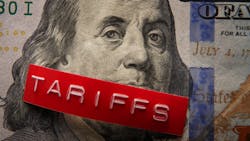ACEC: What Tariffs Mean for Engineering
By DIANA O'LARE, CPSM, director of market intelligence, American Council of Engineering Companies (ACEC)
This article first appeared April 4 on ACEC's First Word blog.
Liberation Day or trade war?
President Trump proclaimed April 2, 2025, to be “Liberation Day,” calling it our nation’s “declaration of economic independence.” The President announced reciprocal tariffs as part of his efforts to onshore domestic manufacturing capacity and bring jobs back to the U.S. It remains to be seen whether these tariffs serve as a calculated negotiation maneuver or if they are a more permanent policy shift, but financial markets didn’t examine motive.
Trump’s announcement sent the markets into freefall in after-hours trading. Overnight, Dow Futures plummeted by 3.16%, the S&P contracted by 3.99%, the Nasdaq suffered a 4.64% downturn, and the downturn continues.
What do economists think?
Economists generally do not like tariffs because they lead to reduced economic activity and supply chain inefficiencies. Tariffs inherently restrict trade, which counters economic principles that favor open markets. Recently, economists at Goldman Sachs adjusted their Q1 GDP forecast, lowering it from 2.2% to 1.7%, a deviation from the 2.5% benchmark indicative of a healthy economy. Concerns have also risen over the potential of retaliatory tariffs from trader partners, alongside the heightened costs of conducting business domestically.
In response to increased tariffs, U.S. companies face a difficult choice: either transfer the cost burden to consumers through higher prices or absorb the expense themselves, thereby diminishing their profit margins.
How about the AEC industry?
Recent tariff policies are creating significant challenges across various sectors, particularly for the engineering industry. According to the ACEC Market Intelligence Committee, home builders and developers preemptively stockpiled materials like lumber and steel to mitigate the effects of looming tariffs. Although lumber and steel were spared in the latest round of reciprocal tariffs, the 25% levies on imports from Canada are projected to directly affect the homebuilding industry.
The National Association of Home Builders (NAHB) has reported that the composite price of lumber rose by 0.4%, marking its highest level since June 2023, and representing a 15.6% increase compared to the prior year. Further price hikes are anticipated. Builders, already struggling due to declining home prices—as highlighted by the S&P CoreLogic Case-Shiller Home Price Index—cannot afford to pass these cost increases on to buyers. This exacerbates the housing shortage and heightens the unaffordability of homes.
For engineering firms, the rising cost of construction materials could impact overall project budgets across multiple public and private markets. Steel and aluminum tariffs introduced by President Trump—mirroring similar measures imposed in 2018—could amplify budget cuts to design firms. While certain countries received exemptions in the past, creating loopholes exploited by China, the current 25% tariff on steel and aluminum imports could push project costs even higher. These costs invariably filter down to projects, compounding financial strain.
The tariffs also have implications for critical resources. Copper, which was excluded from recent reciprocal tariffs, plays a pivotal role in data center development. The Copper Development Association Inc. anticipates a 49% increase in copper consumption by North American data centers from 2020 to 2040. However, the broader impacts of tariff policies on supply chains remain evident.
Onshoring manufacturing to the U.S.—a key objective of these tariffs—requires substantial investment in factories and infrastructure such as roads, water, and sewage systems. This transition will take a considerable amount of time, even with efforts to expedite and streamline permitting processes advocated by the Administration.
Finally, while the Administration’s tariff strategy hasn’t yet explicitly targeted the services sector, there are serious concerns among industry leaders that firms could see new barriers to international markets because of the emerging trade war. Indicators of new restrictions are already appearing with certain provinces in Canada and there are fears that this could spread further.
Is there a long game?
It remains to be seen whether the new tariffs are the opening move in a broader negotiation strategy with key trading partners that results in compromise, or a long-term policy that could weaken the economy and induce inflation, at least in the short term. The Administration argues that increasing the cost of imported goods from foreign nations will incentivize and safeguard domestic industries within the United States.
Most economists see it differently, and depending on how long a trade war persists, voters will ultimately have their say whether more tariffs are putting the economy and the country on the right or wrong track.
#####
Diana O'Lare, CPSM, is ACEC’s director of market intelligence. She can be reached at [email protected].
